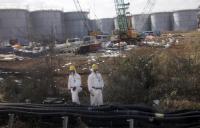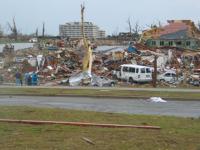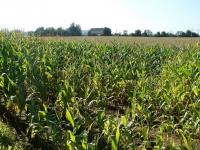-
Update on earthquakes: Newest results from Oklahoma Commission look “encouraging”
The Oklahoma Corporation Commission (OCC), the regulatory agency overseeing the state’s oil and gas industry, now has data that may suggest their directives to owners of production and induction wells have successfully contributed to a decline in seismic activity in the most volatile areas prone to earthquakes.Scientists at the Oklahoma Geological Survey (OGS) continue to remind the public that there are a wide variety of unanswered questions about immediate and long-term remedies even with the new directives in place.
-
-
Fukushima’s lesson: Better real-time monitoring of spent fuel pools is a must

The 2011 Fukushima Daiichi nuclear accident should serve as a wake-up call to nuclear plant operators and regulators on the critical importance of measuring, maintaining, and restoring cooling in spent fuel pools during severe accidents and terrorist attacks, says a new report from the National Academies of Sciences, Engineering, and Medicine.
-
-
Japanese-language MyShake app crowdsources earthquake-shaking information
UC Berkeley scientists have released a Japanese version of an Android app that crowdsources ground-shaking information from smartphones to detect quakes and eventually warn users of impending jolts from nearby quakes. The app, called MyShake, became publicly available on Sunday. Since it was first released in English on 12 February 2016, more than 170,000 people have downloaded the app from around the world, and on any given day 11,000 phones provide data to the system.
-
-
Improving national resiliency: Joplin tornado 5th anniversary

Disaster struck Joplin, Missouri, on 22 May 2011, when the deadliest and costliest single tornado in U.S. history left a 22-mile long path of destruction. The storm killed 161 people, destroyed some 8,000 structures, and left $2.8 billion in damages in its wake. In the five years since the tragedy, the National Institute of Standards and Technology (NIST) has led the effort to learn from the devastation and make improvements based on those lessons so that communities nationwide can become more resilient to tornadoes, significantly reducing both deaths and property damage.
-
-
Changing land uses in California will drive water needs beyond available supply
If past patterns of California land-use change continue, projected water needs by the year 2062 will increase beyond current supply. If historical trends of land use changes to or from urban, agricultural or other uses continue, the result will be increased water-use demand beyond what existing supplies can provide. Large uncertainties associated with weather and climate variability have the potential to exacerbate the problem.
-
-
Decommissioning Fukushima: Mapping boron distribution in molten debris
Decommissioning the Fukushima Daiichi Nuclear Plant just got one step closer. Japanese researchers have mapped the distribution of boron compounds in a model control rod, paving the way for determining re-criticality risk within the reactor.
-
-
Humans have been causing earthquakes in Texas since the 1920s: Study
Earthquakes triggered by human activity have been happening in Texas since at least 1925, and they have been widespread throughout the state ever since, according to a new historical review of the evidence. The earthquakes are caused by oil and gas operations, but the specific production techniques behind these quakes have differed over the decades.
-
-
With drought easing, California rolls back water conservation rules
California announced on Wednesday that it was rolling back mandatory water conservation rules which were put in place at the height of a 4-year drought. The decision to roll back the restrictions came after water conditions in many parts of the state have improved as a result of a wet winter.
-
-
DHS efforts to address EMP threats to the electric grid fall short: GAO

A report by the Government Accounting Office (GAO) found that as of July 2015, the Department of Homeland Security (DHS) has taken several actions that could help address electromagnetic threats to the electric grid. Although these are positive steps, GAO says that its preliminary work indicates that DHS has not effectively coordinated with stakeholders to identify critical assets or collect necessary risk information, among other responsibilities.
-
-
Bringing energy prices down and keeping the lights on
Peak demand is posing an increasing challenge to the U.K.’s electricity system. Researchers at the University of Oxford have launched a five-year program to investigate ways of relieving peak demands on the U.K.’s electricity grid that also might make energy bills cheaper too.
-
-
Mapping Louisiana’s water flow interactions to preserve state’s fresh water

As part of an effort to preserve Louisiana’s fresh water resources, RTI International worked with The Nature Conservancy (TNC) to develop two online tools, released today, that offer a first-of-their-kind look at how Louisiana’s waters interact with each other. These tools will help fishermen, oystermen, planners, decision makers, and all Louisianans understand the state’s unique water flow patterns.
-
-
Water 4.0—the next revolution in urban water systems
In his 2014 book, Water 4.0, UC Berkeley environmental engineer David Sedlak identifies four “revolutions” in the development of urban water systems. Sedlak says that we need a fourth revolution now. Soaring urban populations and a changing climate create chronic water shortages in some cities and too much water in others. Some contaminants may pose hazards in extraordinarily small concentrations. And aging pipe networks threaten the health of entire communities, as seen this year in Flint, Michigan.
-
-
Raccoon brings down grid, cutting power to 40,000 Seattle homes
A raccoon broke into a Seattle, Washington power substation on Wednesday morning and single-handedly (some suggest: single-pawedly) brought down the electrical grid, cutting power to more about 40,000 homes. The raccoon did not stay inside the substation for long, but still managed to cause thirteen separate system outages.
-
-
Building security into cyber-physical systems
We are immersed in a cyber-physical world. Information technology is deeply embedded in traditionally non-IT systems, including automobiles, the electric grid and emergency response. But in many of these systems, security is largely incorporated as a last step, like a suit of armor over a vulnerable body. To help bake security into the very core, a new draft NIST publication recommends ways to incorporate time-tested security design principles and concepts into these systems at every step, from concept to implementation.
-
-
Growing demand for bioenergy threatens global food supply

As countries around the world look for ways to reduce their use of fossil fuels, the growing demand for bioenergy runs the risk of threatening the global food supply. Researchers have developed a certification scheme for biomass resources designed to incorporate food security, to help ensure people in affected regions of the world can continue to put food on their tables.
-
More headlines
The long view
Helping Strengthen America’s Critical Infrastructure
Everyday life depends on a robust infrastructure network that provides access to running water, communications technology and electricity, among other basic necessities. The experts who keep our national infrastructure secure and resilient also need a strong network to share their knowledge and train the next generation of professionals capable of solving complex infrastructure challenges.
AI and the Future of the U.S. Electric Grid
Despite its age, the U.S. electric grid remains one of the great workhorses of modern life. Whether it can maintain that performance over the next few years may determine how well the U.S. competes in an AI-driven world.
Using Liquid Air for Grid-Scale Energy Storage
New research finds liquid air energy storage could be the lowest-cost option for ensuring a continuous power supply on a future grid dominated by carbon-free but intermittent sources of electricity.
Enhanced Geothermal Systems: A Promising Source of Round-the-Clock Energy
With its capacity to provide 24/7 power, many are warming up to the prospect of geothermal energy. Scientists are currently working to advance human-made reservoirs in Earth’s deep subsurface to stimulate the activity that exists within natural geothermal systems.
Experts Discuss Geothermal Potential
Geothermal energy harnesses the heat from within Earth—the term comes from the Greek words geo (earth) and therme (heat). It is an energy source that has the potential to power all our energy needs for billions of years.
